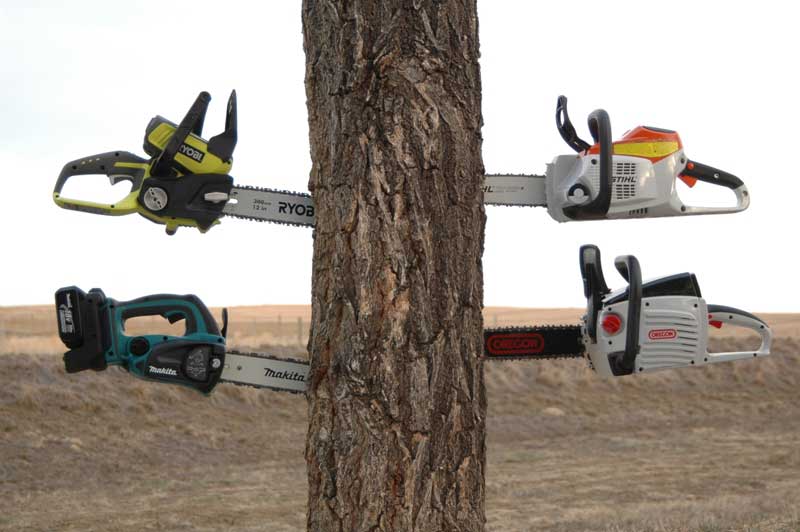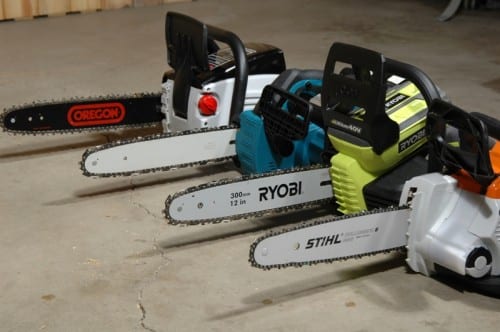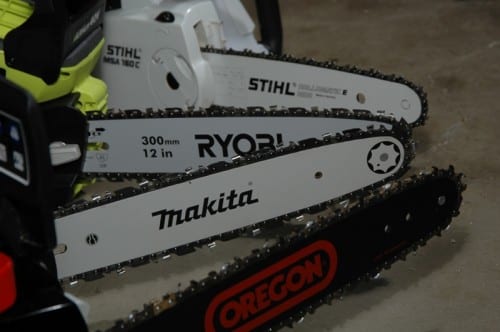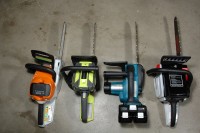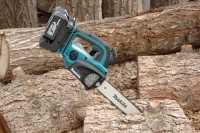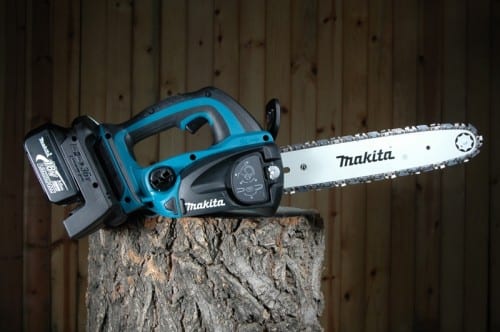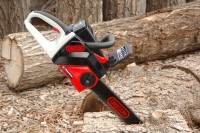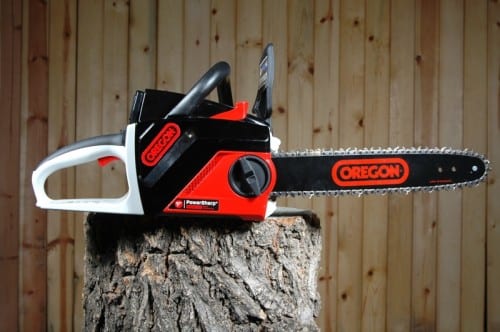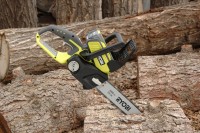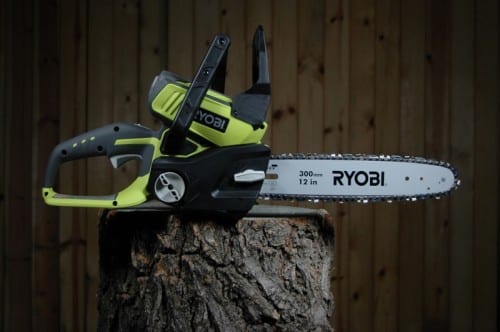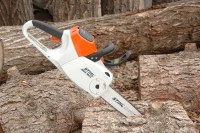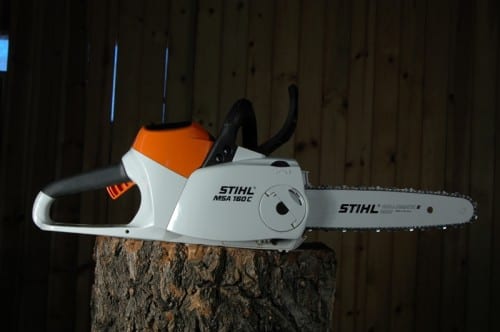A cordless chainsaw won’t replace a full size gas saw, but they’re great for part-time use on the job site, around the property and even in the woodworking shop. Chainsaws and other power-hungry outdoor power equipment (OPE) are a perfect match for large 36V lithium-ion batteries that have proven too big for most handheld cordless tools. Though many common tools are offered in higher voltages, 18V models continue to dominate the cordless tool market as they have for over 15 years. With the rapid advancement of motor and battery technology, many brands’ current 18V tools far outperform their higher voltage tools of just a few years ago. (This is not, however, the case with any 18V chainsaws I’ve tried.) So, besides large rotary hammers, which are staying strong in the 36V category, the biggest “charge” towards this voltage class is being seen in the rapidly growing cordless OPE market. I wanted to see how the current batch of 36V chainsaws stacked up, so reviewing all shipping models in a cordless chainsaw shootout seemed like a great way to satisfy my curiosity.
The Rise of the Machines
Environmental concerns are leading the push in Europe and Scandinavia to replace small gas engines with battery power, and the success of these machines overseas has brought them to our shores. I’ll bet that in the near future we’ll wonder how we ever managed without them—just like we do now with cordless construction tools.
An interesting trend is that chain saws are the tools chosen by companies to premiere their cordless OPE product line before their string trimmers, hedge clippers, blowers and lawnmowers even hit the market. At least that’s the case for all four brands in our test. As I write this, saws from Makita, Oregon, Ryobi and Stihl were the only 36V class tools available for my testing. In the rest of the world, there are other 36V chain saws by Stihl, Husqvarna, Dolmar and Bosch, but none of these have been made available in the U.S. yet.
Making the Chips Fly
Besides using only cordless chain saws on several small tree removal and limb pruning jobs, I also performance tested them on freshly-cut hybrid cottonwood. With new chains installed, I timed aggressive cuts through 6-inch diameter limbs to determine each saw’s relative power and counted how many cuts each saw could make on a full battery charge to test its comparative run-time. I chose saw kits with the biggest battery option, but the Ryobi only comes in a kit with a compact battery.
I tested the saws primarily in green (wet) timber because that’s what they are intended to cut, but I also used the saws in dry lumber to check out their potential for construction uses. Saw chains are designed for the softer structure of green wood, so the saws moved more slowly through kiln dried lumber, but they are still a great tool for quickly cutting any wood larger than your circular saw can handle. And they can cut thick wood faster and straighter than a reciprocating saw outfitted with an extra long blade. Of course, a chain saw is the obvious choice for cutting fence posts, pole barn members and landscape timbers, but trimming large ridge beams made of engineered lumber, and cutting sheathing out of window and door openings are fitting uses on the job, too.
For an arborist or landscaper who uses a gas saw daily, cordless tools aren’t likely to replace any of the saws in their arsenal just yet. Those who use a chain saw less frequently, however, won’t miss mixing and storing 2-stroke fuel or the maintenance hassles of trying to revive a saw that has been sitting too long with old fuel in its carburetor.
Fully Loaded: A List of Favorite Features
Rubber grip surface on rear handle
- Unobtrusive battery port positioned to keep the tool’s center of gravity low
- Long lasting 4.5 Ah (amp-hour) battery with LED fuel gauge
- Low front handle at the tool’s balance point
- Active chain brake
- Tool-free chain tensioning dial
- Tool-free bar locking knob
- Protruding bumper spikes for proper levering action when cutting
- Low kickback, thin kerf bar with sprocket nose
- Low kickback, thin kerf chain
- Brushless motor for high efficiency and battery fuel economy
- Coast-down brake that stops the chain quickly between cuts
- (On back) High capacity oil reservoir with a cap that’s easy to open with gloves on, a wide filler neck and a sight window
Tool by Tool
Makita HCU02ZX2 / HCU02C1
Bar Length: 12 in.
- Chain: 3/8” pitch (low profile), .050” gauge, 46 drive links
- Chain Speed (no load): 27.5 feet per second
- Battery: 2x 18V, 3.0 Ah / 36V, 2.6 Ah
- Weight: 11.2 lbs.
- Sold as: HCU02ZX2 saw with battery adaptor / HCU02C1 kit with saw, 36V battery and charger
- Kit Price: $369 / $549
- Other Prices: 2-pack 18V batteries $171
- Cutting Speed: 7.7 seconds (2nd)
- Run-time: 35 cuts (2nd)
Makita’s saw just arrived in the U.S., so I have had less time with it than the others, but it quickly proved itself to be a strong running, very capable saw. It is being sold in either a 36V battery kit or as the second tool to be offered with Makita’s novel new battery adaptor that was designed to make the brand’s 36V tools more accessible to their existing user base. The adaptor fits two of the brand’s popular 18V lithium-ion batteries (that have remained compatible since 2006). Wired in series, the two 18V batteries basically become a 36V mega-cell. Like batteries in a flashlight, the power output is determined by the one with the lowest voltage, so you have to make sure to use two fully-charged battery packs—you can’t just pair any two up. Because of this, it’s especially nice that the adaptor has an LED fuel gauge for each battery. This makes this new saw one of the few tools by Makita with this beloved feature.
I like the power this gutsy little saw displays—the chain speed stays up under load, and I only managed to stall the saw once. The saw was the second fastest as tested with the 18V battery adaptor setup. I did struggle with the ergonomics of this saw. Makita’s top-handle design balances the tool in your rear hand instead of your front hand, but the short distance between the front and rear handles makes it difficult to apply proper leverage while cutting (when the front of the saw is anchored against the wood, and the front handle is held down while the rear handle is lifted). The off-center front handle also causes the saw to twist in your grip when you push into a cut. I much prefer inline grips, since they allow you to use both hands to push down. Honestly, it ends up being a real strain on the right wrist to have to do all the work. The saw proved back heavy with the double battery adaptor attached but will have much better balance when fitted with the 36V battery it was designed to use.
The saw’s features include an effective chain brake, a coast-down brake to keep you moving in between cuts and a tool-free bar and chain adjuster that’s a cinch to use. In addition, Makita’s saw has the only oil flow adjuster of the bunch.
Oregon PowerNow CS250
Bar Length: 14 in.
- Chain: 3/8” pitch (low profile), .050” gauge, 52 drive links
- Chain Speed (no load): 39.2 feet per second
- Battery: 40V (36V nominal), 1.25 Ah or 2.4 Ah
- Weight (with 2.4 Ah battery): 12.2 lbs.
- Sold as: CS250-S6 kit with saw, 1.25 Ah battery and charger / CS250-E6 kit with saw, 2.4 Ah battery and charger
- Kit Price: $399 / $499
- Other Prices: tool only $249, 1.25 Ah battery $199, 2.4 Ah battery $149
- Cutting Speed: 10.2 seconds (3rd)
- Run-time: 34 cuts (3rd)
Oregon’s saw has every feature of a great saw, but its speed-to-power balance isn’t quite right which casts a shadow over its performance. The saw alternates between being overconfident and overprotective. It has a fast chain speed but not enough power to back it up, so it stalls frequently in use—like it’s in too high a gear. The motor doesn’t slow enough to give you fair warning to ease up, it just cuts out. I had better results in green wood than in dry wood, but during time trials in both I only managed to complete one fast cut without stalling the saw at least once.
A feature that sets this saw apart is the built-in chain sharpening stone that works only with the included PowerSharp chain. For the chain’s teeth to reach the stone (located around the perimeter of the saw’s drive sprocket), they are set wider and taller than standard teeth and therefore take a very aggressive bite. With the sharp leading edge of their teeth protruding twice as far from the center of the chain as standard teeth, this chain demands a lot from the saw. Due to these “grabby” teeth, it’s very hard to start a cut with the chain in the kerf or to make any shaving cuts. Fitting the saw with the brand’s recommended standard tooth replacement chain (91PX) makes it handle better, but to my surprise, the saw cut faster and longer in my tests with the demanding PowerSharp chain. Those results—plus the fact that it’s really nice to be able to sharpen a chain on the fly—keep that chain on my saw, but I always have to be mindful not to push it too hard.
Other features of note on this saw include its 14-inch bar (the longest in the class) and an effective chain brake. Tensioning the chain on this saw was a chore. It required fiddling with a screwdriver instead of being a tool-free operation like that of the other three saws.
Ryobi RY40510
Bar Length: 12 in.
- Chain: 3/8” pitch (low profile), .043” gauge, 45 drive links
- Chain Speed (no load): 11 feet per second
- Battery: 40V (36V nominal), 1.5 Ah or 2.6 Ah
- Weight: (with 1.5 Ah battery) 8.6 lbs., (with 2.6 Ah battery) 9.6 lbs.
- Sold as: RY40510B kit with saw, 1.5 Ah battery and charger
- Kit Price: $189
- Other Prices: Tool-only $100, 1.5 Ah battery $99, 2.6 Ah battery $129, charger $65
- Cutting Speed: 17.1 seconds (4th)
- Run-time: 17 cuts (4th)
Ryobi’s saw is the bargain tool of the bunch. Overall, it is pleasant and comfortable to use, but it’s slow moving and best suited for lighter-duty uses. The tool is geared way down which gives it a slow chain speed but a lot of torque. It’s capable of getting the work done if you are willing to slow your pace enough to not overload the saw. I burned out the first Ryobi I had when using cordless saws to fell some elm trees—it was tough work, but the other tools fared just fine. Its failing was that it never stalled and shut off the motor like the other tools do when they’re overloaded. Instead, it torqued itself right into an early grave with no warning. It seems the circuit that protects the battery doesn’t also protect the motor, so my advice is to take it easy on this saw. The replacement saw is doing fine, but I am wary of really pushing it in use.
The original kit version of this saw came with a full-size, 2.6 Ah battery, but it has since been replaced with a compact, 1.5-amp hour battery. In previous run-time testing, the full-size Ryobi battery put their saw on par with the Oregon model, but in my latest testing with the compact battery, the Ryobi could only do half the work of that competitor. I must say, I was a bigger proponent of this bargain saw when it came with a larger battery. Now that its run-time is curtailed, I find less to recommend. The full-size battery is still available as an accessory, but buying the kit a la carte to get the bigger battery adds over $100 to the cost.
This is the only saw in the test that lacks a chain brake. Instead, it provides protection against kickback with a tip guard that prevents the nose of the bar from contacting anything. Besides limiting the saw’s cut to a mere 9 inches, the tip won’t allow plunge cuts or underbucking wood on the ground. Most users are likely to unscrew the tip to make the saw more useful. Realistically, the slow chain speed of this saw is not likely to cause a catastrophic kickback event, but a chain brake is handy to use as an off switch when checking chain tension or walking around with the saw. For the Ryobi saw, you must unplug the battery to disconnect the power to the trigger. To make this easier, the tool features a secondary battery position that unplugs the electrical contacts while holding the battery, so it can’t fall out of the tool—a thoughtful feature.
As for other features, the saw has a quick and easy tool-free adjuster for the bar and chain and effective bumper spikes on the front for levering cuts. Filling the oil tank proved troublesome, though. The filler neck is too narrow for viscous bar and chain oil, and it’s tucked under the edge of the battery housing which makes it difficult to position the oil jug above.
Stihl MSA160C-BQ
Bar Length: 12 in.
- Chain: 1/4” pitch, .043” gauge, 64 drive links
- Chain Speed (no load): 39.4 feet per second
- Battery: 36V, 2.2 Ah or 4.5 Ah
- Weight (with 4.5 Ah battery): 11.3 lbs.
- Prices (approximate): Tool only $350, 2.2 Ah battery $150, 4.5 Ah battery $260, charger $50, rapid charger $90
- Cutting Speed: 6.0 seconds (1st)
- Run-time: 99 cuts (1st)
Stihl’s saw is a professional grade chain saw in a class all by itself. It is by far the fastest cutting, longest lasting and most comfortable to use. It also has none of the design flaws that compromised the performance of the other saws by comparison. The Stihl simply performed the best in all types of wood and in all situations.
The saw’s sleek design has the battery centrally located deep in the tool. This provides a low center of gravity which greatly benefits a saw’s balance and feel. The Stihl runs more like a gas or corded electric saw than any of the others. It has plenty of pulling power and keeps its chain speed high under load. When you push too hard, it will strain and slow and let you ease up on the cut without instantly stalling out or putting its motor in danger. Its protective overload circuit only kicks in when the saw is really struggling.
One key to this saw’s success is its thin kerf bar and 1/4-inch pitch chain combination. The strategy of thin kerf cutting is all about efficiency—removing less material means less resistance and therefore less work. A chain that removes only one handful of chips during a cut is obviously doing much less work than a chain that removes two handfuls. This is part of the reason this tool cuts much faster than the rest and outlasts the nearest competitor by a margin of nearly three to one.
The other part of the reason is Stihl’s combination of a high-tech brushless motor and an energy-dense 4.5 Ah battery—features that really make this a premium tool, both in performance and price. Other exemplary features are the saw’s tool-free bar, the chain adjustment mechanism, the effective chain brake and a coast down brake which winds down the motor instantly after a cut. Also worthy of note is the extra wide filler neck of the saw’s oil tank. It was large enough that I could pour in thick oil from a gallon jug without making a mess. The only thing I wish this saw had is a battery lock to hold the 36V battery in place during transport. With its latch released and the power disconnected, the battery will sit in its slot, but it will slide out if the saw is turned on its side. An expensive battery crashing to the concrete while the saw is being handled would illustrate the potential benefit of this simple feature in a convincing but devastating way.
Just Missed
Besides the major brands represented in the test, there is also a saw by Greenworks in the 36V category, but their new model was not available at the time of testing.

